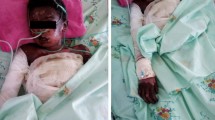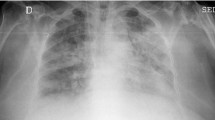Abstract
A 77-year-old female patient with symptomatic atrial fibrillation with fast ventricular rate despite conventional antiarrhythmic therapy was treated with dronedarone. Five days later, she developed a maculopapulous exanthema and small flaccid blisters, which spread over the common integument predominantly located on the dorsal trunk. Over few days, the patient showed a severe epidermal necrolysis of approximately 30 % of the body area and ultimately died in multiorgan failure. Here, we report a rare case of toxic epidermal necrolysis during treatment with dronedarone leading to patient death.



Similar content being viewed by others
References
Schwartz, R. A., McDonough, P. H., & Lee, B. W. (2013). Toxic epidermal necrolysis: Part I. Introduction, history, classification, clinical features, systemic manifestations, etiology, and immunopathogenesis. Journal of the American Academy of Dermatology, 69(2), 173. e1-13.
Schwartz, R. A., McDonough, P. H., & Lee, B. W. (2013). Toxic epidermal necrolysis: Part II. Prognosis, sequelae, diagnosis, differential diagnosis, prevention, and treatment. Journal of the American Academy of Dermatology, 69(2), 187. e1-16.
Hohnloser, S. H., Crijns, H. J., van Eickels, M., Gaudin, C., Page, R. L., Torp-Pedersen, C., & Connolly, S. J. (2009). Athena investigators effect of dronedarone on cardiovascular events in atrial fibrillation. New England Journal of Medicine, 360(7), 668–678.
Miquel, J., Adamski, H., Oger, E., Pollard, E., Le Gall, F., Chevrant-Breton, J., & Dupuy, A. (2012). Febrile maculopapular eruption due to dronedarone. Annales de Dermatologie et de Venereologie, 139(11), 740–742.
European Heart Rhythm Association, European Association for Cardio-Thoracic Surgery, Camm, A. J., Kirchhof, P., Lip, G. Y., Schotten, U., et al. (2010). Guidelines for the management of atrial fibrillation: The task force for the management of atrial fibrillation of the European Society of Cardiology (ESC). European Heart Journal, 19, 2369–2429.
Investigators, P. A. L. L. A. S., Connolly, S. J., Camm, A. J., Halperin, J. L., Joyner, C., Alings, M., et al. (2011). Dronedarone in high-risk permanent atrial fibrillation. New England Journal of Medicine, 365(24), 2268–2276.
Author information
Authors and Affiliations
Corresponding author
Rights and permissions
About this article
Cite this article
Gecks, T., Prochnau, D., Franz, M. et al. Toxic Epidermal Necrolysis During Dronedarone Treatment: First Report of a Severe Serious Adverse Event Of A New Antiarrhythmic Drug. Cardiovasc Toxicol 15, 399–401 (2015). https://doi.org/10.1007/s12012-014-9303-x
Published:
Issue Date:
DOI: https://doi.org/10.1007/s12012-014-9303-x




